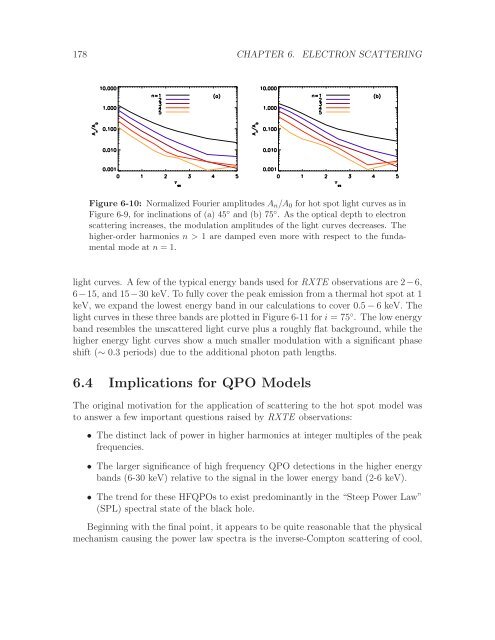Radiation Transport Around Kerr Black Holes Jeremy David ...
Radiation Transport Around Kerr Black Holes Jeremy David ...
Radiation Transport Around Kerr Black Holes Jeremy David ...
You also want an ePaper? Increase the reach of your titles
YUMPU automatically turns print PDFs into web optimized ePapers that Google loves.
178 CHAPTER 6. ELECTRON SCATTERING<br />
Figure 6-10: Normalized Fourier amplitudes A n /A 0 for hot spot light curves as in<br />
Figure 6-9, for inclinations of (a) 45 ◦ and (b) 75 ◦ . As the optical depth to electron<br />
scattering increases, the modulation amplitudes of the light curves decreases. The<br />
higher-order harmonics n > 1 are damped even more with respect to the fundamental<br />
mode at n = 1.<br />
light curves. A few of the typical energy bands used for RXTE observations are 2−6,<br />
6−15, and 15−30 keV. To fully cover the peak emission from a thermal hot spot at 1<br />
keV, we expand the lowest energy band in our calculations to cover 0.5 − 6 keV. The<br />
light curves in these three bands are plotted in Figure 6-11 for i = 75 ◦ . The low energy<br />
band resembles the unscattered light curve plus a roughly flat background, while the<br />
higher energy light curves show a much smaller modulation with a significant phase<br />
shift (∼ 0.3 periods) due to the additional photon path lengths.<br />
6.4 Implications for QPO Models<br />
The original motivation for the application of scattering to the hot spot model was<br />
to answer a few important questions raised by RXTE observations:<br />
• The distinct lack of power in higher harmonics at integer multiples of the peak<br />
frequencies.<br />
• The larger significance of high frequency QPO detections in the higher energy<br />
bands (6-30 keV) relative to the signal in the lower energy band (2-6 keV).<br />
• The trend for these HFQPOs to exist predominantly in the “Steep Power Law”<br />
(SPL) spectral state of the black hole.<br />
Beginning with the final point, it appears to be quite reasonable that the physical<br />
mechanism causing the power law spectra is the inverse-Compton scattering of cool,
















